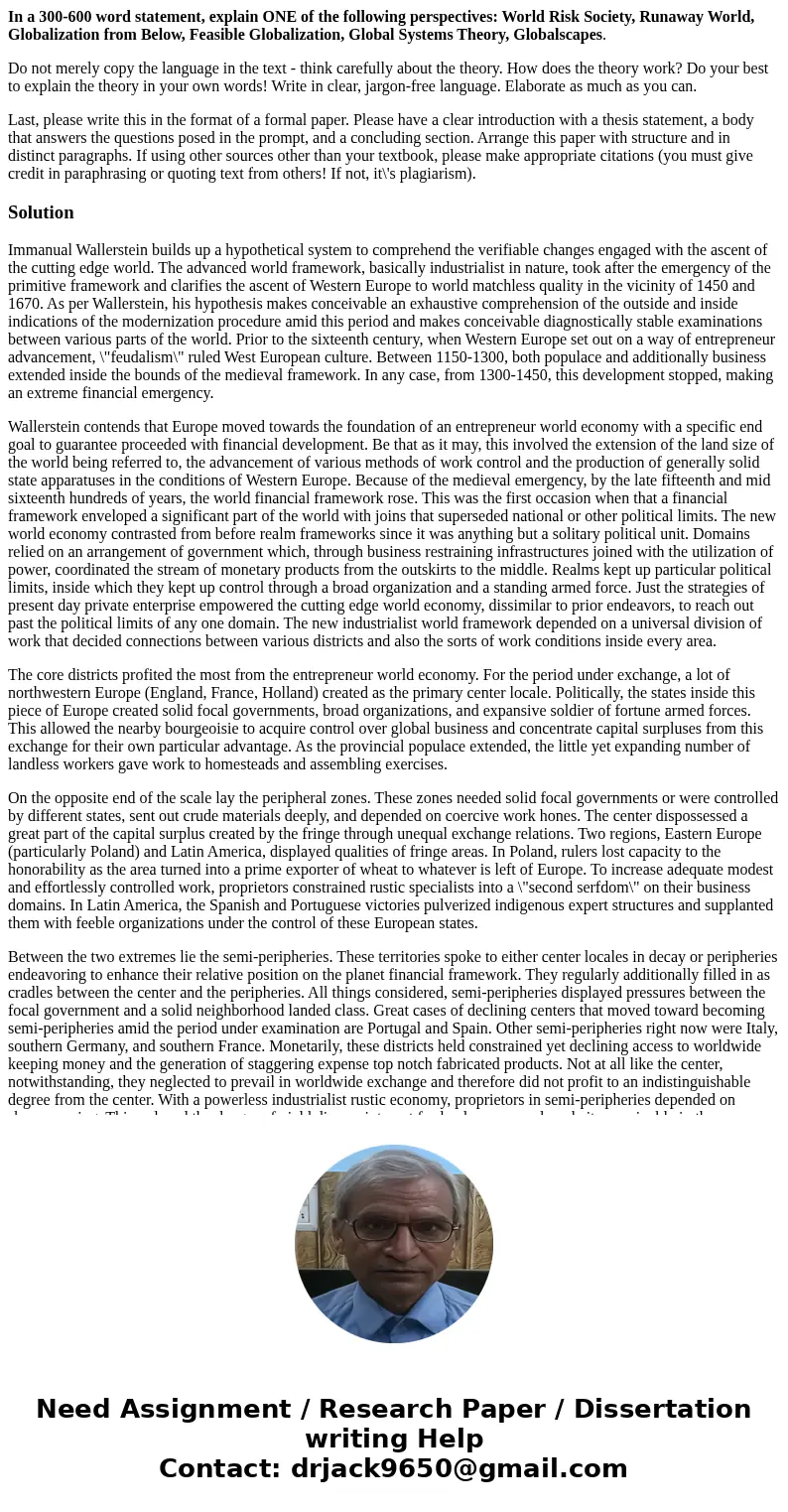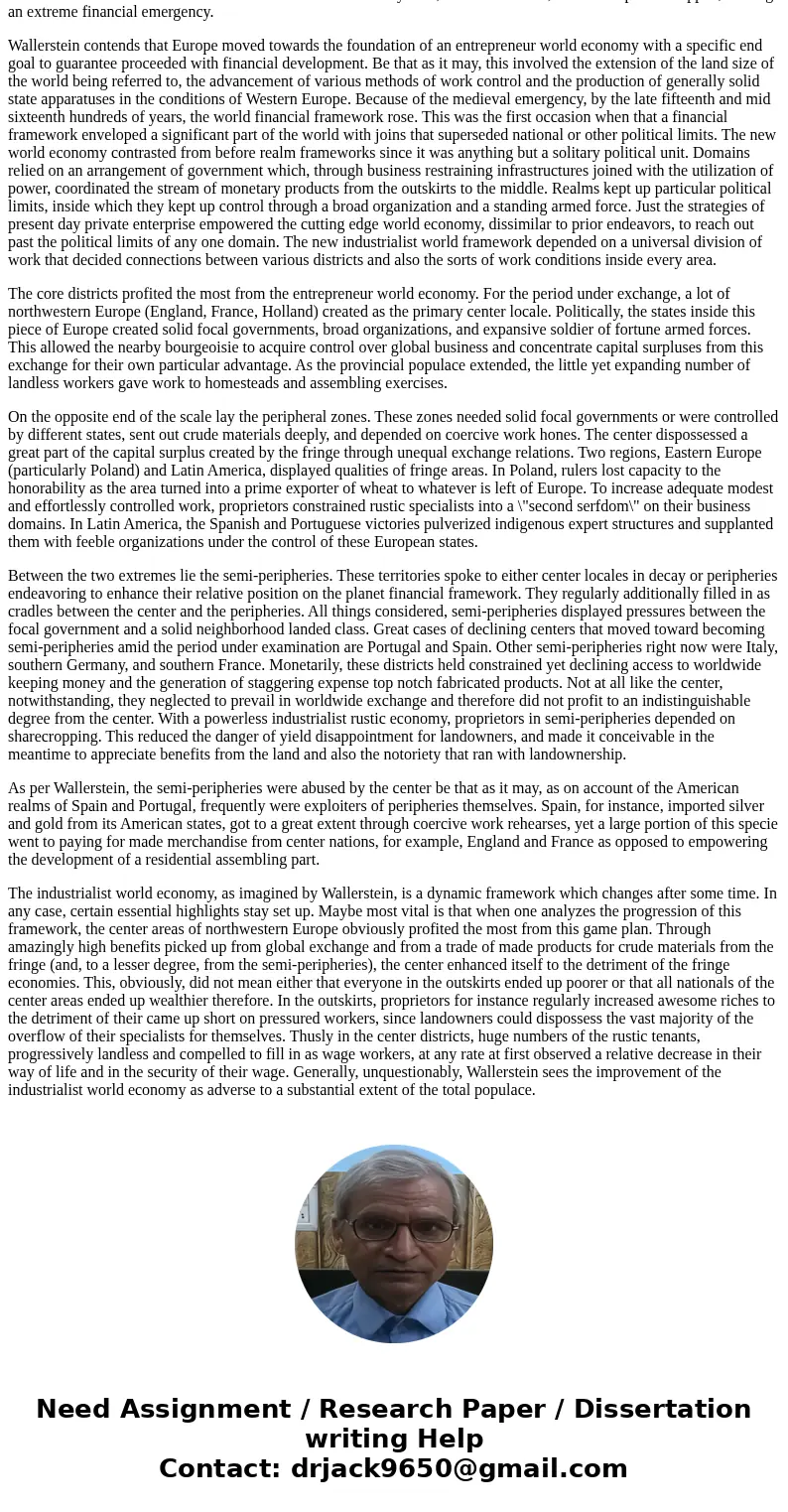In a 300600 word statement explain ONE of the following pers
In a 300-600 word statement, explain ONE of the following perspectives: World Risk Society, Runaway World, Globalization from Below, Feasible Globalization, Global Systems Theory, Globalscapes.
Do not merely copy the language in the text - think carefully about the theory. How does the theory work? Do your best to explain the theory in your own words! Write in clear, jargon-free language. Elaborate as much as you can.
Last, please write this in the format of a formal paper. Please have a clear introduction with a thesis statement, a body that answers the questions posed in the prompt, and a concluding section. Arrange this paper with structure and in distinct paragraphs. If using other sources other than your textbook, please make appropriate citations (you must give credit in paraphrasing or quoting text from others! If not, it\'s plagiarism).
Solution
Immanual Wallerstein builds up a hypothetical system to comprehend the verifiable changes engaged with the ascent of the cutting edge world. The advanced world framework, basically industrialist in nature, took after the emergency of the primitive framework and clarifies the ascent of Western Europe to world matchless quality in the vicinity of 1450 and 1670. As per Wallerstein, his hypothesis makes conceivable an exhaustive comprehension of the outside and inside indications of the modernization procedure amid this period and makes conceivable diagnostically stable examinations between various parts of the world. Prior to the sixteenth century, when Western Europe set out on a way of entrepreneur advancement, \"feudalism\" ruled West European culture. Between 1150-1300, both populace and additionally business extended inside the bounds of the medieval framework. In any case, from 1300-1450, this development stopped, making an extreme financial emergency.
Wallerstein contends that Europe moved towards the foundation of an entrepreneur world economy with a specific end goal to guarantee proceeded with financial development. Be that as it may, this involved the extension of the land size of the world being referred to, the advancement of various methods of work control and the production of generally solid state apparatuses in the conditions of Western Europe. Because of the medieval emergency, by the late fifteenth and mid sixteenth hundreds of years, the world financial framework rose. This was the first occasion when that a financial framework enveloped a significant part of the world with joins that superseded national or other political limits. The new world economy contrasted from before realm frameworks since it was anything but a solitary political unit. Domains relied on an arrangement of government which, through business restraining infrastructures joined with the utilization of power, coordinated the stream of monetary products from the outskirts to the middle. Realms kept up particular political limits, inside which they kept up control through a broad organization and a standing armed force. Just the strategies of present day private enterprise empowered the cutting edge world economy, dissimilar to prior endeavors, to reach out past the political limits of any one domain. The new industrialist world framework depended on a universal division of work that decided connections between various districts and also the sorts of work conditions inside every area.
The core districts profited the most from the entrepreneur world economy. For the period under exchange, a lot of northwestern Europe (England, France, Holland) created as the primary center locale. Politically, the states inside this piece of Europe created solid focal governments, broad organizations, and expansive soldier of fortune armed forces. This allowed the nearby bourgeoisie to acquire control over global business and concentrate capital surpluses from this exchange for their own particular advantage. As the provincial populace extended, the little yet expanding number of landless workers gave work to homesteads and assembling exercises.
On the opposite end of the scale lay the peripheral zones. These zones needed solid focal governments or were controlled by different states, sent out crude materials deeply, and depended on coercive work hones. The center dispossessed a great part of the capital surplus created by the fringe through unequal exchange relations. Two regions, Eastern Europe (particularly Poland) and Latin America, displayed qualities of fringe areas. In Poland, rulers lost capacity to the honorability as the area turned into a prime exporter of wheat to whatever is left of Europe. To increase adequate modest and effortlessly controlled work, proprietors constrained rustic specialists into a \"second serfdom\" on their business domains. In Latin America, the Spanish and Portuguese victories pulverized indigenous expert structures and supplanted them with feeble organizations under the control of these European states.
Between the two extremes lie the semi-peripheries. These territories spoke to either center locales in decay or peripheries endeavoring to enhance their relative position on the planet financial framework. They regularly additionally filled in as cradles between the center and the peripheries. All things considered, semi-peripheries displayed pressures between the focal government and a solid neighborhood landed class. Great cases of declining centers that moved toward becoming semi-peripheries amid the period under examination are Portugal and Spain. Other semi-peripheries right now were Italy, southern Germany, and southern France. Monetarily, these districts held constrained yet declining access to worldwide keeping money and the generation of staggering expense top notch fabricated products. Not at all like the center, notwithstanding, they neglected to prevail in worldwide exchange and therefore did not profit to an indistinguishable degree from the center. With a powerless industrialist rustic economy, proprietors in semi-peripheries depended on sharecropping. This reduced the danger of yield disappointment for landowners, and made it conceivable in the meantime to appreciate benefits from the land and also the notoriety that ran with landownership.
As per Wallerstein, the semi-peripheries were abused by the center be that as it may, as on account of the American realms of Spain and Portugal, frequently were exploiters of peripheries themselves. Spain, for instance, imported silver and gold from its American states, got to a great extent through coercive work rehearses, yet a large portion of this specie went to paying for made merchandise from center nations, for example, England and France as opposed to empowering the development of a residential assembling part.
The industrialist world economy, as imagined by Wallerstein, is a dynamic framework which changes after some time. In any case, certain essential highlights stay set up. Maybe most vital is that when one analyzes the progression of this framework, the center areas of northwestern Europe obviously profited the most from this game plan. Through amazingly high benefits picked up from global exchange and from a trade of made products for crude materials from the fringe (and, to a lesser degree, from the semi-peripheries), the center enhanced itself to the detriment of the fringe economies. This, obviously, did not mean either that everyone in the outskirts ended up poorer or that all nationals of the center areas ended up wealthier therefore. In the outskirts, proprietors for instance regularly increased awesome riches to the detriment of their came up short on pressured workers, since landowners could dispossess the vast majority of the overflow of their specialists for themselves. Thusly in the center districts, huge numbers of the rustic tenants, progressively landless and compelled to fill in as wage workers, at any rate at first observed a relative decrease in their way of life and in the security of their wage. Generally, unquestionably, Wallerstein sees the improvement of the industrialist world economy as adverse to a substantial extent of the total populace.


 Homework Sourse
Homework Sourse